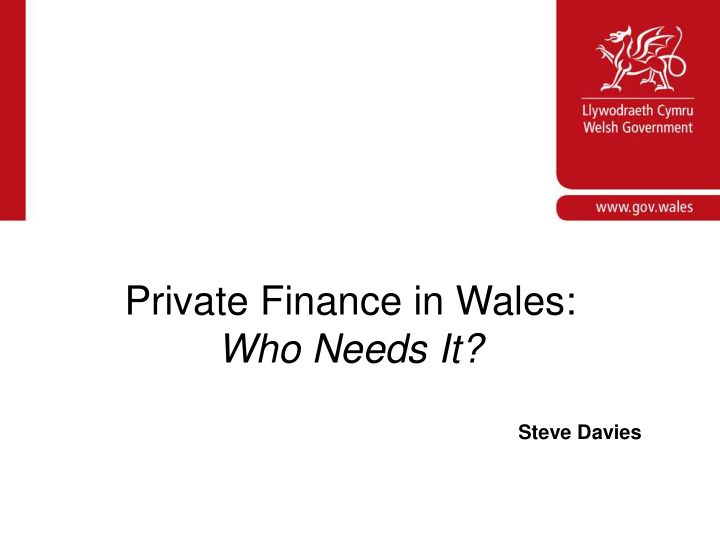



Private Finance in Wales: Who Needs It? Steve Davies
What are we going to talk about? • (Very) brief introduction to PFI • Consideration of the evolution of the model in Scotland and subsequently in England • History of PFI in Wales • Drivers for changing attitudes in Wales • Current status of the Welsh Mutual Investment Model
Historic PFI • PFI introduced in the UK in the early 1990s • Foresaw private sector responsibility for DBFO / DBFM • Always controversial (in the UK): • Ideological: Private control of public infrastructure • Financial: Poor Value for Money; reduces spending on services • Statistical: Masking public liabilities • Culminated in the publication of critical Parliamentary reports in 2011
PFI in Wales • Wales never enthusiastic about historic PFI • Welsh Government has never undertaken PFI and only 23 schemes across the Welsh public sector • Equates to a little over half a billion of historic PFI investment in Wales, whereas Northern Ireland has undertaken £2 billion, Scotland around £6 billion, and England well over £50 billion • Around £180 per head in Wales, relative to around £1000 per head in the other parts of the UK
PFI in Wales • In terms of funding historic PFI liabilities through the revenue budget, the cost – around £100 million pa – equates to less than 1% per annum of the current Revenue budget • In contrast, Scotland is spending 5% of its total budget to fund private finance schemes. • Provided funding available for infrastructure from capital budgets, no worries.
Drivers for change • But following financial crisis, things changed.
Drivers for change • Government commits to examine innovative ways to fund additional public infrastructure • Significant reductions in capital spending power, following successive cuts to the budget; • Relatively low level of historic PFI debt; • The opportunity to take advantage of the historically low cost of (private) borrowing; and • Recognition of the fact that appropriately targeted infrastructure investment is one of the main ways government intervention can contribute to growth and jobs.
New approaches to PFI • England introduces PF2 following critical Parliamentary reports: • Public and third-party equity • A new model adopted in Scotland: the Non-profit Distributing (NPD) model • Defining characteristics: • Public control • Fixed price returns to private investors
Hubris and Hamartia • In March 2014 Government agrees to undertake three Public Private Partnerships (PPPs) with capital value of £1 billion • Intention is to use NPD model. • But NPD model runs aground in July 2015 as EU statisticians consider NPD investment = public investment. • Decision rests on public control and profit capping provisions.
Anagnorisis and Catastrophe • Serious budgetary ramifications – capital value of schemes must score in capital budgets. • As a result, investment using NPD model is not additional, merely displaces other capital investment. • Sparks a bit of a crisis across the EU, as PPPs typically based on UK contracts or feature state involvement, e.g., in financing structures.
Catharsis? • Development of the Welsh Mutual Investment Model • Sharing (but not capping) profits • Sharing in the earnings of a PPP by taking equity • Exercising influence (but not control) • The right to appoint a Director. Ensures transparency and unrestricted access to information
Does Brexit matter? • Post-secession, statistical regime very unlikely to change or to be interpreted differently • There could be an impact on the willingness of contractors to prioritise the UK market… • …or on the cost of private capital • European Investment Bank (EIB) finance might no longer be available
Current Status • Cabinet approved, 27 September • Biggest challenge getting Ministers comfortable with the idea that they can decide what to buy and how to pay for it, but not how it’s delivered • Office of National Statistics (ONS) review ongoing. • Decision expected in December. Watch this space
Recommend
More recommend